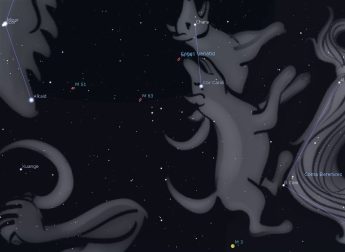This Week’s Sky at a Glance, 2024 March 23 – March 30
This Week’s Sky at a Glance, 2024 March 23 – March 30
Although Orion and his two dogs, Canis Major and Canis Minor, are slipping into the sunset, they are not the only pooches in the night sky. The small constellation of Canes Venatici the Hunting Dogs is generally seen as a pair of stars well below the handle of the Big Dipper. They assist their master, Boötes, in chasing the celestial bears around the pole.
In one tale from mythology Boötes is Icarius, a vineyard owner who was taught the art of winemaking by Bacchus. He introduced his shepherd neighbours to his product, and when they awoke with a hangover the next morning they thought they had been poisoned. In retaliation they killed Icarius and threw him in a ditch. His dogs, Chara and Asterion, sensed something was wrong, and when they eventually found their master they jumped into the ditch to die with him.
The brightest star in Canes Venatici is a double star called Cor Caroli, which means the Heart of Charles. Edmond Halley coined this because it was said to have shone brightly when Charles II returned to London after his defeat by Cromwell. The other naked eye star in the constellation is Chara, from the Greek word for joy. Halfway between Cor Caroli and Arcturus, the brightest star in Boötes, you can see a fuzzy patch with binoculars. This is the globular star cluster M3 from Messier’s catalogue. Galaxy M94 lies just north of the midpoint between Cor Caroli and Chara; and the much-imaged Whirlpool Galaxy is within the borders of Canes Venatici, despite being near the handle of the Big Dipper.
This Week in the Solar System
Saturday’s sunrise is at 7:20 and sunset will occur at 7:41, giving 12 hours, 21 minutes of daylight. Next Saturday the Sun will rise at 7:07 and set at 7:50, giving 12 hours, 43 minutes of daylight.
The Moon is full and in penumbral eclipse very early on Monday morning. Ambitious people might notice a subtle gray shade across the Moon between 3 and 4:30. Mercury will be at its evening best for the year this week, reaching greatest elongation from the Sun on Sunday and setting 105 minutes after sunset. By the end of the week Jupiter will be setting at 11 pm, and on Thursday telescope users might get their last view of its Red Spot for several months between 9 and 10 pm. Mars rises an hour before the Sun midweek, followed by Saturn and Venus over the next 40 minutes, but they are difficult binocular targets in bright morning twilight. Beginning midweek we have a two-week opportunity to observe the subtle wedge of zodiacal light in the west about 90 minutes after sunset.
On Sunday evening at 8 pm, tune in to the Sunday Night Astronomy Show via the Facebook page or YouTube channel of Astronomy by the Bay.
Weekly Sky at a Glance ~by Curt Nason

